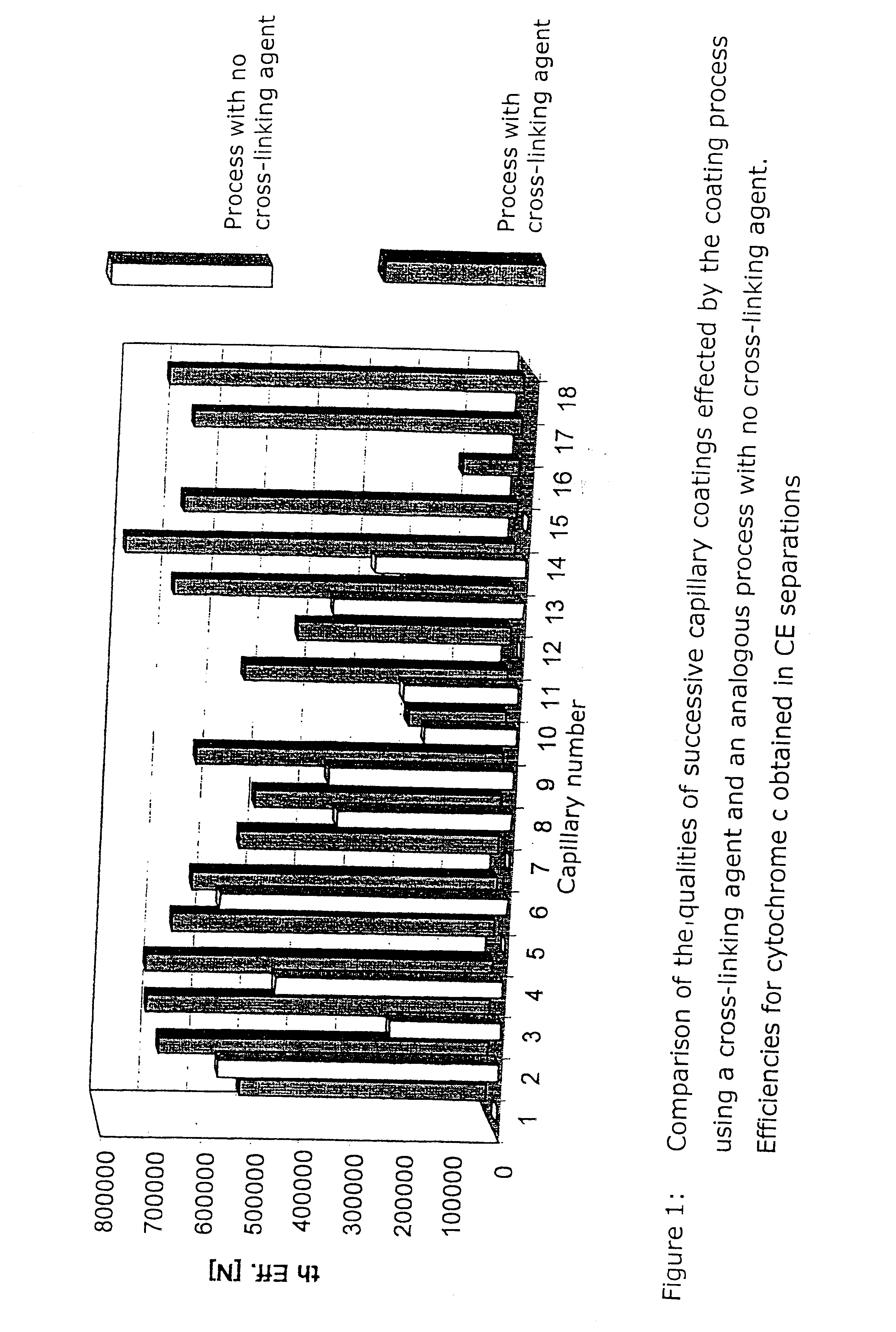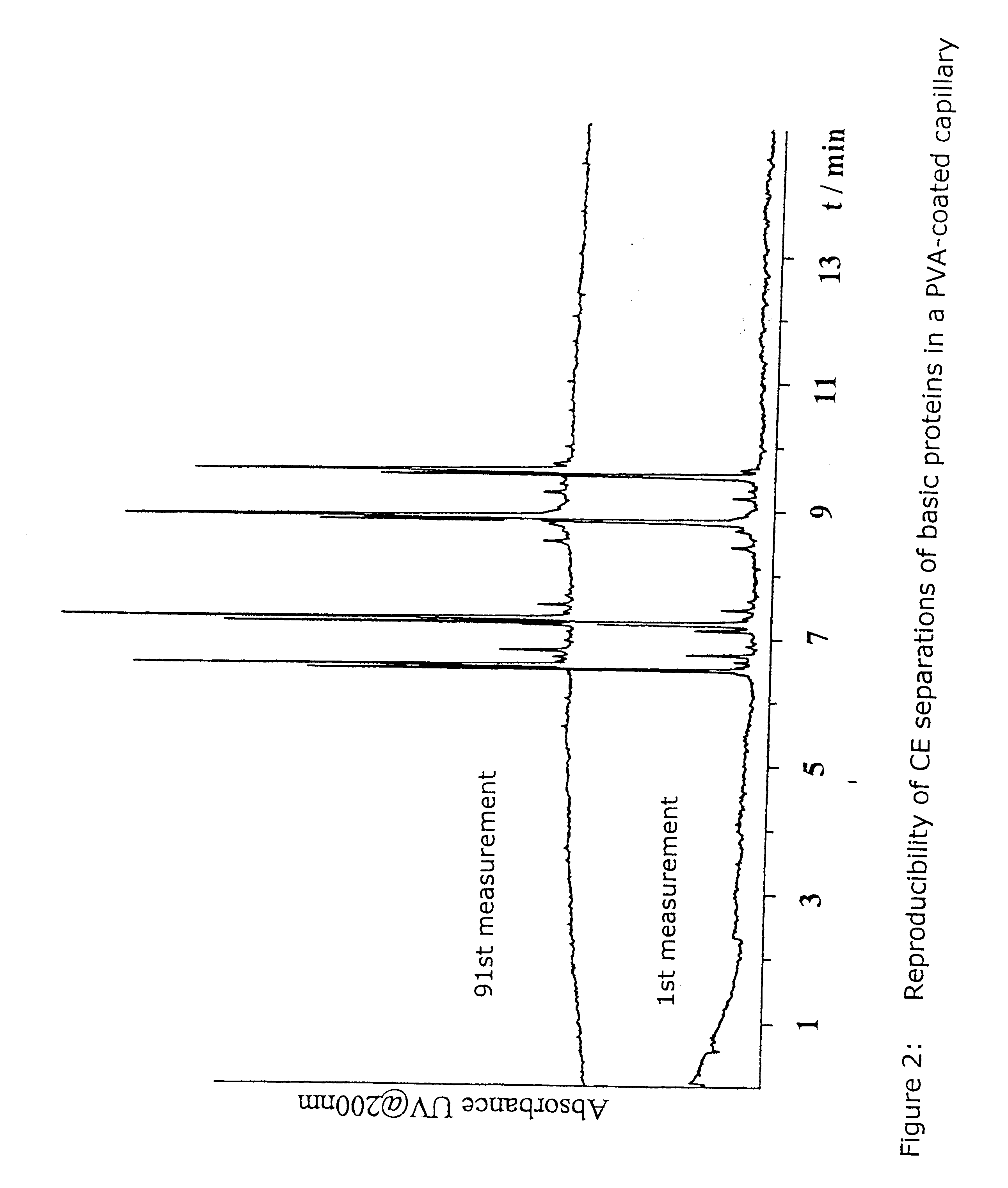Coatings with cross-linked hydrophilic polymers
- Summary
- Abstract
- Description
- Claims
- Application Information
AI Technical Summary
Benefits of technology
Problems solved by technology
Method used
Image
Examples
example 2
PVA Capillaries with No Thermal Aftertreatment
Two capillaries were coated with PVA by analogy with Example 1, but without the subsequent thermal treatment. Two freshly coated capillaries were dried in a nitrogen flow for different periods of time, and the capillaries obtained were then tested for use in capillary electrophoresis by analogy with Example 1. The test mixture consisted of basic proteins: (1) cytochrome c, (2) lysozyme, (3) trypsin, (4) trypsinogen, and (5) .alpha.-chymotrypsinogen. The electropherograms obtained and a comparison with a separation obtained in an uncoated capillary are shown in FIG. 3. In an uncoated capillary, efficient separations cannot be obtained due to strong adsorption of the proteins; the highly adsorptive protein cytochrome c is even completely adsorbed and does not elute from the column, see FIG. 3A. With a PVA capillary prepared according to the present process, highly efficient signals from all test compounds are obtained. If the drying of the...
example 3
Capillary-electrophoretic Separation of Basic Dendrimers
With a capillary prepared by analogy with Example 1, basic dendrimers were analyzed. These compounds are highly adsorptive with respect to fused silica. Therefore, an uncoated capillary can provide only a poor CE separation due to the peak broadening of the adsorbed analytes, see FIG. 4A. However, if the separation is effected with the same experimental parameters, but with a PVA-coated capillary, adsorption of the compounds to the capillary wall is effectively suppressed, and very sharp signals are obtained. This is shown in FIG. 4B.
PVA capillaries can also be run with electrolytes containing very high proportions of organic solvents, which is necessary, in particular, for the coupling of CE with a mass spectrometer (MS). The CE separation of dendrimers in an MS-compatible electrolyte is shown in FIG. 4C.
Experimental Conditions
Analyte concentration: 1 mg / ml, voltage: 15 kV, detection: UV 200 nm, electrolytes: A, B: 40 mM Na ph...
example 4
Suppression of EOF Over a Broad pH Range
With a capillary prepared by analogy with Example 1, the dependence of the electroosmotic flow on the pH value of an aqueous electrolyte was determined. Thus, Na phosphate buffers were titrated to the corresponding pH values; the electroosmotic flow was determined from the migration time of the neutral marker DMSO. In FIG. 5, the results obtained for a PVA capillary are compared with the corresponding results for an uncoated capillary. In a capillary coated with PVA by the present process, the EOF is suppressed over a broad pH range, and in contrast to uncoated capillaries, it is almost independent of the pH value.
PUM
| Property | Measurement | Unit |
|---|---|---|
| Hydrophilicity | aaaaa | aaaaa |
Abstract
Description
Claims
Application Information
 Login to View More
Login to View More - R&D
- Intellectual Property
- Life Sciences
- Materials
- Tech Scout
- Unparalleled Data Quality
- Higher Quality Content
- 60% Fewer Hallucinations
Browse by: Latest US Patents, China's latest patents, Technical Efficacy Thesaurus, Application Domain, Technology Topic, Popular Technical Reports.
© 2025 PatSnap. All rights reserved.Legal|Privacy policy|Modern Slavery Act Transparency Statement|Sitemap|About US| Contact US: help@patsnap.com



